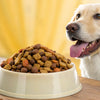Enhancing Your Dog's Diet: What Can I Put on Dry Dog Food?
- Houndsy
Table of Contents
- Introduction
- The Importance of a Balanced Diet
- Nutritious Additions to Dry Dog Food
- Portion Control and Balance
- Keeping Mealtime Engaging
- Houndsy’s Commitment to Enhancing the Feeding Experience
- Conclusion
Introduction
Did you know that over 60% of dog owners in the U.S. choose dry kibble as their dog’s primary food source? While kibble is convenient and affordable, many pet owners have questions about how to enhance this staple to better meet their furry friends' nutritional needs and make mealtime more enjoyable. If you’ve ever wondered, “What can I put on dry dog food?” you’re not alone.
In this blog post, we’ll explore a variety of nutritious additions you can mix with dry dog food to elevate your pet's diet. From savory proteins to tasty vegetables, we will provide insights into the nutritional benefits of these toppers and how to introduce them into your dog's feeding routine. By the end of this article, you'll have a comprehensive understanding of how to make kibble more appealing and beneficial for your canine companion.
We'll cover safe and nutritious options, portion sizes, and tips for ensuring a balanced diet. Plus, we will touch upon the importance of convenience, health, and aesthetics in pet care—values that resonate deeply with our mission at Houndsy. So, let’s dive in and transform your dog’s mealtime experience!
The Importance of a Balanced Diet
Before we delve into specific mix-ins, it’s crucial to understand the significance of a balanced diet for dogs. Just like humans, dogs thrive on a variety of nutrients, including proteins, fats, carbohydrates, vitamins, and minerals. While high-quality kibble provides a solid foundation, adding fresh foods can enhance flavor, texture, and nutritional content.
Incorporating fresh ingredients into your dog's diet can help address specific health needs, improve digestion, and keep your pet engaged during mealtime. However, it’s essential to remember that any additions should complement, not replace, the core diet. Generally, fresh foods should only account for about 10-25% of your dog's daily caloric intake to maintain nutritional balance.
Benefits of Adding Fresh Foods
- Enhanced Nutrition: Fresh foods can provide additional vitamins and minerals that may not be present in kibble.
- Improved Palatability: Dogs can be picky eaters! Fresh food toppers can make dry kibble more inviting.
- Variety in Flavor: Adding different ingredients keeps mealtime exciting, which can encourage your dog to eat.
- Better Digestive Health: Many fresh foods contain fiber that aids digestion and helps maintain a healthy gut.
Nutritious Additions to Dry Dog Food
1. Proteins
Adding protein sources is a fantastic way to enhance your dog’s diet. Here are some excellent options:
Cooked Chicken or Turkey
Lean meats like chicken and turkey are excellent sources of protein that your dog will love. Ensure they are cooked without any added spices, onions, or garlic. You can shred or chop the meat into small pieces to mix easily with kibble.
Eggs
Eggs are a nutritional powerhouse for dogs. They are rich in protein and contain essential fatty acids. You can serve them hard-boiled, scrambled, or even raw (if they are pasteurized). A general rule is to offer about half an egg for smaller dogs and a full egg for larger breeds.
Fish
Sardines, salmon, or mackerel packed in water (not oil) can be a great addition. They are high in omega-3 fatty acids, promoting healthy skin and coat. Just be sure to remove any bones and monitor the portion size to prevent excessive weight gain.
2. Dairy Products
Many dogs enjoy dairy, and it can provide a source of calcium and protein.
Plain Greek Yogurt
Greek yogurt is an excellent source of probiotics, which can aid digestion. Just a spoonful or two can give your kibble a creamy boost. Ensure you choose plain yogurt without sugars or artificial sweeteners.
Cottage Cheese
Cottage cheese is a low-fat option that many dogs love. It can enhance the texture of dry food and add protein. Start with small amounts, as some dogs may be lactose intolerant.
3. Vegetables
Vegetables can offer additional nutrients and fiber. Here are some dog-friendly options:
Cooked Carrots and Green Beans
These veggies are low in calories and high in fiber, making them great for weight management. Cook them until tender and chop them into small pieces to mix with kibble.
Pumpkin
Canned pumpkin (not the spiced pie filling) is a fantastic source of fiber and can help with digestive issues. Add a tablespoon to your dog’s food for a nutrient boost.
Sweet Potatoes
Rich in vitamins and antioxidants, sweet potatoes can be cooked and mashed before mixing in. They are a great source of carbohydrates and provide energy.
4. Fruits
Fruits can be a sweet treat for dogs, but not all are safe. Here are some safe options:
Apples
Sliced apples (without seeds) can offer crunch and sweetness. They are high in fiber and vitamins A and C.
Blueberries
These little berries are packed with antioxidants and are low in calories. They can be a fun addition to your dog’s bowl.
Bananas
Bananas can be given in moderation as they are higher in sugar. A few slices can make a delightful topping.
5. Healthy Fats
Healthy fats are essential for overall health. Here are some options to consider:
Coconut Oil
Adding a teaspoon of coconut oil can improve your dog’s coat and skin health. It’s a source of healthy fats and can also aid digestion.
Fish Oil
Fish oil supplements can provide essential omega-3 fatty acids. Be sure to consult your vet for the right dosage.
Portion Control and Balance
When introducing new foods, it’s essential to keep portion sizes in mind. Start with small amounts of any new ingredient, gradually increasing as needed while monitoring for any adverse reactions. A good rule of thumb is to ensure that the fresh foods account for no more than 10-25% of your dog's daily caloric intake.
Additionally, always consult with your veterinarian before making significant changes to your dog’s diet. They can provide personalized recommendations based on your dog’s health needs, age, and lifestyle.
Keeping Mealtime Engaging
Dogs thrive on routine, but that doesn't mean their meals need to be monotonous. Here are some tips to keep mealtime exciting:
- Rotate Ingredients: Change up the mix-ins regularly to provide variety.
- Interactive Feeders: Consider using a slow feeder or puzzle bowl to stimulate your dog's mind during meals.
- Experiment with Textures: Some dogs prefer crunchy textures while others enjoy softer foods. Find out what your dog likes best!
Houndsy’s Commitment to Enhancing the Feeding Experience
At Houndsy, we believe in elevating the dog-feeding experience through innovative design and functionality. Our flagship product, the Houndsy Kibble Dispenser, not only provides perfect portion control but also fits beautifully into your home décor. With a large capacity and ergonomic design, it simplifies feeding time, making it a delightful experience for both you and your furry friend.
If you're interested in elevating your dog’s mealtime, explore our Houndsy Kibble Dispenser today, and experience the convenience and elegance of a modern feeding solution.
Conclusion
Feeding your dog should be a joyful experience that nurtures their body and spirit. By adding nutritious ingredients to their dry dog food, you can enhance their diet, keep mealtime interesting, and ensure they receive a balanced nutrition that supports their health and well-being.
Remember, every dog is unique, and what works for one might not work for another. Monitor your dog’s reactions to new foods, and consult your veterinarian if you have any concerns. We also encourage you to explore the Houndsy Kibble Dispenser to streamline your feeding routine and make mealtime even more enjoyable.
FAQ
1. Can I mix wet dog food with dry dog food?
Yes, mixing wet and dry dog food can enhance flavor and moisture, making the meal more appealing to your dog.
2. How do I know if a food is safe for my dog?
Always research and ensure that any new food is safe for dogs. Avoid toxic foods like grapes, raisins, onions, and garlic.
3. How much of a new food should I add to my dog’s diet?
Start with small amounts (a teaspoon or two) and monitor your dog's tolerance. Fresh foods should generally make up no more than 10-25% of their daily caloric intake.
4. Is it safe to give my dog bones?
Raw bones can be safe for dogs, but cooked bones can splinter and cause harm. Always supervise your dog with bones and consult your vet for recommendations.
5. Where can I learn more about dog nutrition?
Consulting your veterinarian is the best way to get personalized advice. There are also many reputable books and websites dedicated to dog nutrition.
By enriching your dog’s diet with various fresh foods, you’re not just enhancing their meals—you’re expressing your love and care for their overall health and happiness. Happy feeding!












